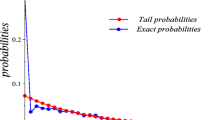Abstract
This paper presents an analytical method to calculate the waiting time distribution for the G/G/1-queueing system with batch arrivals. Using the discrete time scale, it is possible to calculate the distribution of the waiting times and the idle times of a G/G/1-queueing system based on the Wiener–Hopf factorization. The influence of batch arrivals on the waiting time distribution is analyzed. The waiting time distribution is calculated for batch arrivals with both constant and stochastic batch sizes. The effect of stochastic batch sizes on the waiting process is highlighted. With the developed methods, it is possible to obtain congestion measures of high precision for logistic systems. The analytical results are evaluated by simulation. Several numerical examples are presented to emphasize the quality of the introduced methods.
Similar content being viewed by others
References
Ackroyd HM (1980). Computing the waiting time distribution for the G/G/1 queue by signal processing methods. IEEE Trans Comm 38(1):52–58
Bailey NTJ (1954). On queueing processes with bulk service. J R Stat Soc 16:80–87
Buzacott JA, Shantikumar J (1993). Stochastic models of manufacturing systems. Prentice Hall, Englewood Cliffs
Calabress JM, Hausmann WH (1991). Simultaneous determination of lot sizes and routing mix in job shops. Manage Sci 37(8):1043–1059
Chaudhry ML, Templeton JGC (1983). A first course in bulk queues. Wiley, New York
Curry GL, Deuermeyer BL (2002). Renewal approximation for the departure process of batch systems. IIE Trans 34:95–104
Dümmler M (1998). Analysis of the departure process of a batch service queueing system. Technical report. Lehrstuhl für Informatik III
Furmans K (2004) A framework of stochastic finite elements for models of material handling systems. In: Progress in material handling research: 2004, vol 8. International Material Handling Research Colloquium, Graz
Gnedenko BW, König D (1983). Handbuch der bedientheorie I, vol, 1. Akademie-Verlag, Berlin
Gold H (1992). Performance modelling of batch service systems with push and pull manufacturing management policies. Dissertation, Universität Würzburg
Grassmann WK, Jain JL (1988). Numerical Solution for the departure process from the GI/G/1 queue. Comput Operat Res. 15(3):293–296
Grassmann WK, Jain JL (1989). Numerical solutions of the waiting time distribution and idle time distribution of the arithmetic GI/G/1 queue. Operat Res 37(1):141–150
Kleinrock L (1975). Theory. queueing systems, vol. 1. Wiley, New York
Livny M, Melamed B, Tsiolis AK (1993). The impact of autocorrelation on queuing systems. Manage Sci 39:322–339
Meng G, Heragu S (2004). Batch size modeling in a multi-item, discrete manufacturing system via an open queueing network. IIE trans 36:743–753
Neuts MF (1967). A general class of bulk queues with Poisson input. Ann Math Stat 38(2):759–770
Tran-Gia P (1996). Analytische leistungsbewertung verteilter systeme. Springer, Berlin Heidelberg New York
Whitt W (1983). Queueing network analyser. Bell Syst Tech J 62(9):2779–2815
Wolff RW (1989). Stochastic modelling and the theory of queues. Prentice Hall, Englewood Cliffs
Author information
Authors and Affiliations
Corresponding author
Rights and permissions
About this article
Cite this article
Schleyer, M., Furmans, K. An analytical method for the calculation of the waiting time distribution of a discrete time G/G/1-queueing system with batch arrivals. OR Spectrum 29, 745–763 (2007). https://doi.org/10.1007/s00291-006-0065-0
Published:
Issue Date:
DOI: https://doi.org/10.1007/s00291-006-0065-0



